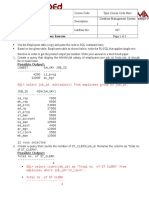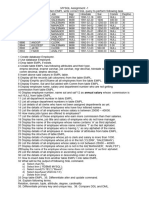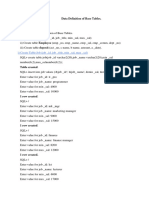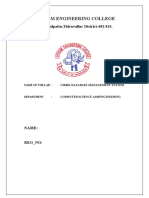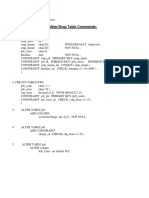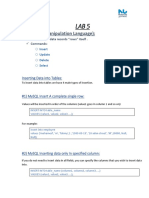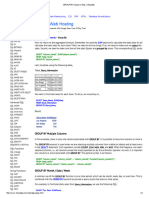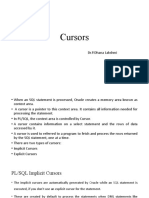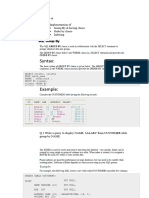Practice 5: Maximum Minimum Sum Average
Practice 5: Maximum Minimum Sum Average
Uploaded by
Junary Daniela MUNOZ JIMENEZCopyright:
Available Formats
Practice 5: Maximum Minimum Sum Average
Practice 5: Maximum Minimum Sum Average
Uploaded by
Junary Daniela MUNOZ JIMENEZOriginal Title
Copyright
Available Formats
Share this document
Did you find this document useful?
Is this content inappropriate?
Copyright:
Available Formats
Practice 5: Maximum Minimum Sum Average
Practice 5: Maximum Minimum Sum Average
Uploaded by
Junary Daniela MUNOZ JIMENEZCopyright:
Available Formats
Practice 5
Determine the validity of the following three statements. Circle either True or False.
1. Group functions work across many rows to produce one result per group.
True/False
2. Group functions include nulls in calculations.
True/False
3. The WHEREclause restricts rows prior to inclusion in a group calculation.
True/False
4. Display the highest, lowest, sum, and average salary of all employees. Label the columns
Maximum, Minimum, Sum, and Average, respectively. Round your results to the nearest whole
number. Place your SQL statement in a text file named lab5_6.sql.
SELECT ROUND(MAX(salary),0) "Maximum",
ROUND(MIN(salary),0) "Minimum",
ROUND(SUM(salary),0) "Sum",
ROUND(AVG(salary),0) "Average"
FROM employees;
Maximum Minimum Sum Average
24000 2100 691400 6462
5. Modify the query in lab5_4.sqlto display the minimum, maximum, sum, and average salary for
each job type. Resave lab5_4.sqlto lab5_5.sql. Run the statement in lab5_5.sql.
Introduction to Oracle9i: SQL 5-28
Practice 5 (continued)
SELECT job_id, ROUND(MAX(salary),0) "Maximum",
ROUND(MIN(salary),0) "Minimum",
ROUND(SUM(salary),0) "Sum",
ROUND(AVG(salary),0) "Average"
FROM employees
GROUP BY job_id
job_id Maximum Minimum Sum Average
SH_CLERK 4200 2500 64300 3215
AD_VP 17000 17000 34000 17000
SA_MAN 14000 10500 61000 12200
PU_MAN 11000 11000 11000 11000
IT_PROG 9000 4200 28800 5760
ST_CLERK 3600 2100 55700 2785
FI_MGR 12000 12000 12000 12000
PU_CLERK 3100 2500 13900 2780
HR_REP 6500 6500 6500 6500
ST_MAN 8200 5800 36400 7280
Introduction to Oracle9i: SQL 5-29
Practice 5 (continued)
MK_MAN 13000 13000 13000 13000
AC_MGR 12000 12000 12000 12000
SA_REP 11500 6100 250500 8350
AD_ASST 4400 4400 4400 4400
PR_REP 10000 10000 10000 10000
MK_REP 6000 6000 6000 6000
AD_PRES 24000 24000 24000 24000
FI_ACCOUNT 9000 6900 39600 7920
AC_ACCOUNT 8300 8300 8300 8300
6. Write a query to display the number of people with the same job.
SELECT job_id, COUNT(*)
FROM employees
GROUP BY job_id;
job_id count
SH_CLERK 20
AD_VP 2
Introduction to Oracle9i: SQL 5-30
Practice 5 (continued)
SA_MAN 5
PU_MAN 1
IT_PROG 5
ST_CLERK 20
FI_MGR 1
PU_CLERK 5
HR_REP 1
ST_MAN 5
MK_MAN 1
AC_MGR 1
SA_REP 30
AD_ASST 1
PR_REP 1
MK_REP 1
Introduction to Oracle9i: SQL 5-31
Practice 5 (continued)
AD_PRES 1
FI_ACCOUNT 5
AC_ACCOUNT 1
7. Determine the number of managers without listing them. Label the column Number of
Managers. Hint:Use the MANAGER_IDcolumn to determine the number of managers.
SELECT COUNT(DISTINCT manager_id) "Number of Managers"
FROM employees;
Number of Managers
19
Introduction to Oracle9i: SQL 5-32
Practice 5 (continued)
8. Write a query that displays the difference between the highest and lowest salaries. Label the column
DIFFERENCE.
If you have time, complete the following exercises:
SELECT MAX(salary) - MIN(salary) DIFFERENCE
FROM employees;
difference
21900.00
9. Display the manager number and the salary of the lowest paid employee for that manager.
Exclude anyone whose manager is not known. Exclude any groups where the minimum
salary is less than $6,000. Sort the output in descending order of salary.
Introduction to Oracle9i: SQL 5-33
Practice 5 (continued)
SELECT manager_id, MIN(salary)
FROM employees
WHERE manager_id IS NOT NULL
GROUP BY manager_id
HAVING MIN(salary) > 6000
ORDER BY MIN(salary) DESC;
manager_id min
0 24000.00
102 9000.00
205 8300.00
146 7000.00
145 7000.00
108 6900.00
149 6200.00
147 6200.00
148 6100.00
Introduction to Oracle9i: SQL 5-34
Practice 5 (continued)
10. Write a query to display each department’s name, location, number of employees, and the
average salary for all employees in that department. Label the columns Name, Location,
Number of People, and Salary, respectively. Round the average salary to two decimal
places.
If you want an extra challenge, complete the following exercises:
SELECT d.department_name "Name", d.location_id "Location ",
COUNT(*) "Number of People",
ROUND(AVG(salary),2) "Salary"
FROM employees e, departments d
WHERE e.department_id = d.department_id
GROUP BY d.department_name, d.location_id;
Name Location Number of People
Human 2400 1
Resources
Purchasing 1700 6
Finance 1700 6
Administration 1700 1
Shipping 1500 45
Accounting 1700 2
Introduction to Oracle9i: SQL 5-35
Practice 5 (continued)
Public Relations 2700 1
Sales 2500 34
Marketing 1800 2
IT 1400 5
Executive 1700 3
11. Create a query that will display the total number of employees and, of that total, the number of
employees hired in 1995, 1996, 1997, and 1998. Create appropriate column headings.
SELECT COUNT(*) total,
SUM(DECODE(TO_CHAR(hire_date, 'YYYY'),1995,1,0))"1 995",
SUM(DECODE(TO_CHAR(hire_date, 'YYYY'),1996,1,0))"1 996",
SUM(DECODE(TO_CHAR(hire_date, 'YYYY'),1997,1,0))"1 997",
SUM(DECODE(TO_CHAR(hire_date, 'YYYY'),1998,1,0))"1 998"
FROM employees;
12. Create a matrix query to display the job, the salary for that job based on department number, and
the total salary for that job, for departments 20, 50, 80, and 90, giving each column an
appropriate heading.
Introduction to Oracle9i: SQL 5-36
Practice 5 (continued)
SELECT job_id "Job",
SUM(DECODE(department_id , 20, salary)) "Dept 20" ,
SUM(DECODE(department_id , 50, salary)) "Dept 50" ,
SUM(DECODE(department_id , 80, salary)) "Dept 80" ,
SUM(DECODE(department_id , 90, salary)) "Dept 90" ,
SUM(salary) "Total"
FROM employees
GROUP BY job_id;
Introduction to Oracle9i: SQL 5-37
You might also like
- Dianne Auld's Excel Tips: Featuring Compensation and Benefits Formulas Third EditionFrom EverandDianne Auld's Excel Tips: Featuring Compensation and Benefits Formulas Third EditionNo ratings yet
- SQL Fundamentals I Solutions 04Document3 pagesSQL Fundamentals I Solutions 04megadrive007No ratings yet
- IbeRomarie-Laboratory Exercise 7Document4 pagesIbeRomarie-Laboratory Exercise 7AaPrince Shiroe Yajirobi100% (2)
- My New Moving Vehicle DB2MOVE "With More POWER and Less Gas"Document10 pagesMy New Moving Vehicle DB2MOVE "With More POWER and Less Gas"Renu Sharma100% (1)
- Practice 5 (Continued)Document8 pagesPractice 5 (Continued)John Paul Duque GutierrezNo ratings yet
- Class 12 Ip Practical FileDocument14 pagesClass 12 Ip Practical Filelawige7947No ratings yet
- Oracle Analytical Functions 1Document18 pagesOracle Analytical Functions 1Redrouthu JayaprakashNo ratings yet
- CubeRollup Slides PDFDocument27 pagesCubeRollup Slides PDFSumit KNo ratings yet
- MYSQLAssignment 1Document2 pagesMYSQLAssignment 1PinchuNo ratings yet
- Acuña, Lance IT6202 LAB - 008Document2 pagesAcuña, Lance IT6202 LAB - 008Anime LoverNo ratings yet
- HTTP WWW - AkadiaDocument17 pagesHTTP WWW - Akadiaapi-3823655100% (1)
- Ex No: 1. Data Definition of Base Tables. Date: AimDocument30 pagesEx No: 1. Data Definition of Base Tables. Date: Aimvinothselvaraj462No ratings yet
- 5 Aggregating DataDocument21 pages5 Aggregating DataPaulNo ratings yet
- Update CommandDocument7 pagesUpdate CommandshashianireddyNo ratings yet
- Final Term Lab ManualDocument8 pagesFinal Term Lab ManualtasnimNo ratings yet
- Manipulating Large Data Sets & Retrieving Data Using SubqueriesDocument4 pagesManipulating Large Data Sets & Retrieving Data Using Subquerieskeyboard_47No ratings yet
- Practice 3, Part 1 1.: Introduction To Oracle9i: SQL 3Document15 pagesPractice 3, Part 1 1.: Introduction To Oracle9i: SQL 3John Paul Duque GutierrezNo ratings yet
- Acuña, Lance IT6202 LAB - 007Document4 pagesAcuña, Lance IT6202 LAB - 007Anime LoverNo ratings yet
- Lab Number 1Document6 pagesLab Number 1sbnking21No ratings yet
- Assignment#7Document1 pageAssignment#7api-3827483No ratings yet
- XII CS DBMS & SQL Connectivity & Networking-WorksheetDocument4 pagesXII CS DBMS & SQL Connectivity & Networking-WorksheettherealsadbroccoliNo ratings yet
- PROG3113 Part 2Document7 pagesPROG3113 Part 2GuideLinesNo ratings yet
- Advanced SQL (Part 1) Nataliya BogushevskayaDocument48 pagesAdvanced SQL (Part 1) Nataliya BogushevskayajuliyagorelikNo ratings yet
- Practice 4 PDFDocument5 pagesPractice 4 PDFuserNo ratings yet
- SQL AssignmentDocument3 pagesSQL Assignmentbookworm_shashi100% (2)
- Tarala Leizel L8 MultipleRow-LabExer008Document3 pagesTarala Leizel L8 MultipleRow-LabExer008Liezel Panganiban Tarala0% (1)
- Practice 2: Introduction To Oracle9i: SQL 2Document10 pagesPractice 2: Introduction To Oracle9i: SQL 2John Paul Duque GutierrezNo ratings yet
- Database Management SystemDocument56 pagesDatabase Management SystemAnand RajNo ratings yet
- Practice Assignment of Data BaseDocument5 pagesPractice Assignment of Data Basemehreenshahid789No ratings yet
- DBMS PoDocument75 pagesDBMS PoVani RajasekharNo ratings yet
- Abir Chakraborty - 22312204Document26 pagesAbir Chakraborty - 22312204wefot57202No ratings yet
- Employee Management System (EMS) : I. Complete The Following AssignmentDocument4 pagesEmployee Management System (EMS) : I. Complete The Following AssignmentSachin BishtNo ratings yet
- 12 06 12 12 03 53 Shyamsundar PDFDocument32 pages12 06 12 12 03 53 Shyamsundar PDFsameerroushanNo ratings yet
- SQL Queries PracticeDocument8 pagesSQL Queries Practicelikae tr100% (1)
- Answers To SQL Practice QuestionsDocument20 pagesAnswers To SQL Practice Questionsnuwandara abeykoonNo ratings yet
- Experiment No - 1: A) B) Construct Appropriate Tables For The Above ER Diagram?Document32 pagesExperiment No - 1: A) B) Construct Appropriate Tables For The Above ER Diagram?Make jokesNo ratings yet
- Practical Examination 2020 Ip Set 1Document3 pagesPractical Examination 2020 Ip Set 1sofia gupta100% (1)
- Xii Sample Practical File 2024Document30 pagesXii Sample Practical File 2024Sreyash BaishkhiyarNo ratings yet
- HAVING in SQL - 1keydataDocument2 pagesHAVING in SQL - 1keydatavickroid007No ratings yet
- Worksheet SQL and ConnectivityDocument3 pagesWorksheet SQL and ConnectivitypushpalkrpandeyNo ratings yet
- S 45Document2 pagesS 45anon_466730668No ratings yet
- Lab 5Document17 pagesLab 5Mohamed AdelNo ratings yet
- Database Programming: Using Rollup and Cube Operations, and Grouping SetsDocument34 pagesDatabase Programming: Using Rollup and Cube Operations, and Grouping SetsKevin Van MalderenNo ratings yet
- EC611 - (CH 06) Production Theory & EstimationDocument33 pagesEC611 - (CH 06) Production Theory & Estimationsilverster_123No ratings yet
- SC 233511728547272 AssignmentDocument2 pagesSC 233511728547272 AssignmentlalithathammishettyNo ratings yet
- Case-Study SolutionDocument4 pagesCase-Study SolutionSrinidhi AdyaNo ratings yet
- DP 15 3 PracticeDocument3 pagesDP 15 3 PracticeRidwansyah DaduNo ratings yet
- SQL Test1Document50 pagesSQL Test1Akhil Ahmed50% (2)
- SQL Fundamentals - Practice 05Document6 pagesSQL Fundamentals - Practice 05Abby ARNo ratings yet
- Experiment: Programs Related Function: Steps For Experiment/practical: (A) : ANSWERDocument7 pagesExperiment: Programs Related Function: Steps For Experiment/practical: (A) : ANSWERVijay MauryaNo ratings yet
- SQL Queries ExerciseDocument53 pagesSQL Queries Exerciseganeshjavvadi100% (3)
- DBMSSRGC EmployeeDocument7 pagesDBMSSRGC EmployeeStudent LifeNo ratings yet
- Practice 5: Introduction To Oracle9i: SQL 5-28Document3 pagesPractice 5: Introduction To Oracle9i: SQL 5-28Andres Santiago MonsalveNo ratings yet
- DBMS LAB 2020-21 (Updated)Document24 pagesDBMS LAB 2020-21 (Updated)Amrutha VarshaNo ratings yet
- Details About DDM LabDocument33 pagesDetails About DDM LabShamilsha100% (1)
- GROUP BY Clause in SQL - 1keydataDocument2 pagesGROUP BY Clause in SQL - 1keydatavickroid007No ratings yet
- Practica 4 y 5Document12 pagesPractica 4 y 5drockVolta0% (1)
- Data Base and Management System LabDocument8 pagesData Base and Management System LabArsalan IshtiaqNo ratings yet
- Optimizing Factory Performance: Cost-Effective Ways to Achieve Significant and Sustainable ImprovementFrom EverandOptimizing Factory Performance: Cost-Effective Ways to Achieve Significant and Sustainable ImprovementNo ratings yet
- Finding Alphas: A Quantitative Approach to Building Trading StrategiesFrom EverandFinding Alphas: A Quantitative Approach to Building Trading StrategiesRating: 4 out of 5 stars4/5 (1)
- What Is Sql ?: Fundamentals of Sql,T-Sql,Pl/Sql and Datawarehousing.From EverandWhat Is Sql ?: Fundamentals of Sql,T-Sql,Pl/Sql and Datawarehousing.No ratings yet
- Readings in Database Systems: Fifth EditionDocument54 pagesReadings in Database Systems: Fifth EditionLuis Segundo Chuello ChirinosNo ratings yet
- MS SQLDocument46 pagesMS SQLKeerthi MenonNo ratings yet
- H 2Document173 pagesH 2zocsiNo ratings yet
- Understanding and Using API User HooksDocument23 pagesUnderstanding and Using API User HooksmariocelisNo ratings yet
- Important 19c New FeatureDocument2 pagesImportant 19c New Featurekrishna.setwinNo ratings yet
- KibanaDocument12 pagesKibanarajNo ratings yet
- TriggerDocument19 pagesTriggerohioprincess13No ratings yet
- SCN and Instance RecoveryDocument9 pagesSCN and Instance RecoveryRahul KumarNo ratings yet
- C - Sc. - Practical File For 2022 - HYDocument2 pagesC - Sc. - Practical File For 2022 - HYArpan MukherjeeNo ratings yet
- Postgresql 11 A4 PDFDocument2,621 pagesPostgresql 11 A4 PDFGiuliano PertileNo ratings yet
- RDBMS 10Document11 pagesRDBMS 10kaniksha sharmaNo ratings yet
- Multi-Threading Processes: The ConceptDocument5 pagesMulti-Threading Processes: The ConceptNenad KiticNo ratings yet
- My Friends Has Attended ODIDocument5 pagesMy Friends Has Attended ODIचंदन जैसवालNo ratings yet
- Oracle SQL Query TuningDocument15 pagesOracle SQL Query TuningRayNo ratings yet
- CursorsDocument14 pagesCursorsSasidhar GanugapentaNo ratings yet
- Department of Computer Science & Engineering Question Bank Unit I Introduction and Conceptual Modelling PART-A (2 Marks)Document7 pagesDepartment of Computer Science & Engineering Question Bank Unit I Introduction and Conceptual Modelling PART-A (2 Marks)debpanchami0% (1)
- Databricks, An Introduction: Chuck Connell, Insight Digital InnovationDocument36 pagesDatabricks, An Introduction: Chuck Connell, Insight Digital InnovationSaravanan1234567No ratings yet
- Oracle PL/SQL Best Practice 2.1 Overview: 1.1 ScopeDocument7 pagesOracle PL/SQL Best Practice 2.1 Overview: 1.1 ScopeJunaid UsmanNo ratings yet
- Application Developers Guide PDFDocument520 pagesApplication Developers Guide PDFSantanu DasNo ratings yet
- Purging Workflow DataDocument9 pagesPurging Workflow DataieuserforeverNo ratings yet
- DBMS Lab 6Document3 pagesDBMS Lab 6BCA SY 63 Aaditi RanawareNo ratings yet
- 5.1 Java SwingDocument139 pages5.1 Java SwingJulie Raj100% (2)
- PostgreSQL Python TutorialDocument28 pagesPostgreSQL Python Tutorialdoguno7025No ratings yet
- DBMS Unit-5Document9 pagesDBMS Unit-5Manoj Kumar ChouhanNo ratings yet
- Oracle Basic and Advanced SQLDocument211 pagesOracle Basic and Advanced SQLphyo nyi aungNo ratings yet
- Oracle® Database Patch 22243551 - Database Patch For Engineered Systems and DB In-Memory 12.1.0.2Document10 pagesOracle® Database Patch 22243551 - Database Patch For Engineered Systems and DB In-Memory 12.1.0.2Thiago MedeirosNo ratings yet
- Deepika - SQL DeveloperDocument6 pagesDeepika - SQL DeveloperMadhav GarikapatiNo ratings yet
- Simon Kamau Dbms JTDocument203 pagesSimon Kamau Dbms JTrobin wanjalaNo ratings yet
- Constraints in DBMS - Types of Constraints in DBMS - Gate VidyalayDocument5 pagesConstraints in DBMS - Types of Constraints in DBMS - Gate VidyalayBivek Man SinghNo ratings yet


